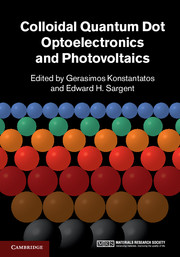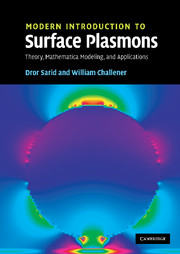Refine listing
Actions for selected content:
881 results in Ebooks in nanotechnology
9 - Heterojunction solar cells based on colloidal quantum dots
-
-
- Book:
- Colloidal Quantum Dot Optoelectronics and Photovoltaics
- Published online:
- 05 November 2013
- Print publication:
- 07 November 2013, pp 233-255
-
- Chapter
- Export citation
8 - Optical gain and lasing in colloidal quantum dots
-
-
- Book:
- Colloidal Quantum Dot Optoelectronics and Photovoltaics
- Published online:
- 05 November 2013
- Print publication:
- 07 November 2013, pp 199-232
-
- Chapter
- Export citation
4 - Charge and energy transfer in polymer/nanocrystal blends
-
-
- Book:
- Colloidal Quantum Dot Optoelectronics and Photovoltaics
- Published online:
- 05 November 2013
- Print publication:
- 07 November 2013, pp 87-111
-
- Chapter
- Export citation
6 - Colloidal quantum dot light emitting devices
-
-
- Book:
- Colloidal Quantum Dot Optoelectronics and Photovoltaics
- Published online:
- 05 November 2013
- Print publication:
- 07 November 2013, pp 148-172
-
- Chapter
- Export citation
Contents
-
- Book:
- Colloidal Quantum Dot Optoelectronics and Photovoltaics
- Published online:
- 05 November 2013
- Print publication:
- 07 November 2013, pp v-x
-
- Chapter
- Export citation
5 - Multiple exciton generation in semiconductor quantum dots and electronically coupled quantum dot arrays for application to thirdgeneration photovoltaic solar cells
-
-
- Book:
- Colloidal Quantum Dot Optoelectronics and Photovoltaics
- Published online:
- 05 November 2013
- Print publication:
- 07 November 2013, pp 112-147
-
- Chapter
- Export citation
1 - Engineering colloidal quantum dots
-
-
- Book:
- Colloidal Quantum Dot Optoelectronics and Photovoltaics
- Published online:
- 05 November 2013
- Print publication:
- 07 November 2013, pp 1-29
-
- Chapter
- Export citation
Preface
-
- Book:
- Colloidal Quantum Dot Optoelectronics and Photovoltaics
- Published online:
- 05 November 2013
- Print publication:
- 07 November 2013, pp xiii-xiv
-
- Chapter
- Export citation
3 - Electronic structure and optical transitions in colloidal semiconductor nanocrystals
-
-
- Book:
- Colloidal Quantum Dot Optoelectronics and Photovoltaics
- Published online:
- 05 November 2013
- Print publication:
- 07 November 2013, pp 59-86
-
- Chapter
- Export citation
Index
-
- Book:
- Colloidal Quantum Dot Optoelectronics and Photovoltaics
- Published online:
- 05 November 2013
- Print publication:
- 07 November 2013, pp 310-314
-
- Chapter
- Export citation
Contributors
-
-
- Book:
- Colloidal Quantum Dot Optoelectronics and Photovoltaics
- Published online:
- 05 November 2013
- Print publication:
- 07 November 2013, pp xi-xii
-
- Chapter
- Export citation
Colloidal Quantum Dot Optoelectronics and Photovoltaics - Half title page
-
- Book:
- Colloidal Quantum Dot Optoelectronics and Photovoltaics
- Published online:
- 05 November 2013
- Print publication:
- 07 November 2013, pp i-ii
-
- Chapter
- Export citation
11 - Semiconductor quantum dot sensitized TiO2 mesoporous solar cells
-
-
- Book:
- Colloidal Quantum Dot Optoelectronics and Photovoltaics
- Published online:
- 05 November 2013
- Print publication:
- 07 November 2013, pp 292-309
-
- Chapter
- Export citation
7 - Colloidal quantum dot photodetectors
-
-
- Book:
- Colloidal Quantum Dot Optoelectronics and Photovoltaics
- Published online:
- 05 November 2013
- Print publication:
- 07 November 2013, pp 173-198
-
- Chapter
- Export citation
Colloidal Quantum Dot Optoelectronics and Photovoltaics - Title page
-
-
- Book:
- Colloidal Quantum Dot Optoelectronics and Photovoltaics
- Published online:
- 05 November 2013
- Print publication:
- 07 November 2013, pp iii-iii
-
- Chapter
- Export citation
2 - Aqueous based colloidal quantum dots for optoelectronics
-
-
- Book:
- Colloidal Quantum Dot Optoelectronics and Photovoltaics
- Published online:
- 05 November 2013
- Print publication:
- 07 November 2013, pp 30-58
-
- Chapter
- Export citation
Copyright page
-
- Book:
- Colloidal Quantum Dot Optoelectronics and Photovoltaics
- Published online:
- 05 November 2013
- Print publication:
- 07 November 2013, pp iv-iv
-
- Chapter
- Export citation
10 - Solution-processed infrared quantum dot solar cells
-
-
- Book:
- Colloidal Quantum Dot Optoelectronics and Photovoltaics
- Published online:
- 05 November 2013
- Print publication:
- 07 November 2013, pp 256-291
-
- Chapter
- Export citation

Colloidal Quantum Dot Optoelectronics and Photovoltaics
-
- Published online:
- 05 November 2013
- Print publication:
- 07 November 2013

Modern Introduction to Surface Plasmons
- Theory, Mathematica Modeling, and Applications
-
- Published online:
- 05 May 2013
- Print publication:
- 06 May 2010
